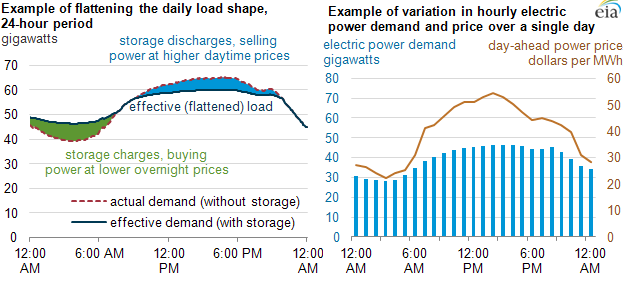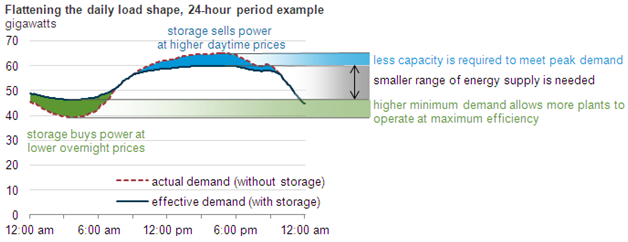The following was provided by the U.S. Energy Information Association:

Source: U.S. Energy Information Administration.
Electricity storage technologies that can operate on timescales such as hours or days are often deployed at specific times of day to take advantage of variations in the price of electricity (see chart above, right). Storage operators can buy electricity when prices are lower (overnight or on weekends), store it, and then discharge or deliver it later, selling the stored electricity when prices are higher (daytime, weekdays). Following a previous article introducing electricity storage technologies and functions, this article focuses on technologies that operate on these longer timescales, or energy management technologies, and their two overarching benefits to the electric power system: flattening the daily load shape (see chart above, left) and integrating variable generation like wind.
The first chart above illustrates the practice behind the concept of "load shifting" or "load leveling." When electric demand is low, operators seek to increase the effective demand by moving power to storage. When demand is high, operators seek to decrease effective demand by using stored energy to generate electricity. Pumped hydroelectric storage is one example of this approach. Overnight, a reversible hydroelectric turbine is powered by low-cost electricity from the grid, using it to pump water "uphill", to a reservoir at a higher elevation. During the daytime peak hours, this water is then released back "downhill" and through the hydroelectric turbine to produce electricity, which is sold to the grid at the higher, on-peak prices.
This load-shifting function has beneficial effects on the electric power system:
- Lowering the effective peak demand on the system can reduce the requirement for peaking generators, which are particularly expensive to operate. With a lower effective peak demand, operators can defer infrastructure improvements, such as new generators or transmission additions.
- Using storage to create a higher effective demand overnight allows more facilities to operate as baseload resources, enhancing their operating efficiency. Often, power plants have to lower their output or shut down entirely overnight to avoid oversupplying the grid with power. There can be significant efficiency losses and costs associated with reduced output or temporary shutdown of baseload plants.

Source: U.S. Energy Information Administration.
Renewable generators such as wind and solar often have significant variability in their output over the course of the day. Concentrating solar plants can store solar heat in an oil or molten salt, allowing them to continue generating power through cloud passage or after the sun sets. In most locations, wind resources are more available overnight, when demand is low. Storage facilities might store wind-generated electricity overnight, when the wind is most available, and release electricity when demand is higher—time-shifting the supply to meet the demand.
Pumped hydroelectric is the most prevalent energy management storage technology, with 22 gigawatts (GW) of capacity installed in the United States. Other technologies are also in use. Compressed air technology uses low-cost electricity to store pressurized air underground, and then releases that pressure later to support the operation of a combustion turbine. Some batteries, particularly flow batteries (based on liquid rather than solid chemistries), have the characteristics needed for energy management. The Department of Energy's Energy Storage Database currently lists four demonstration-type flow battery-based projects (as of April 2012). Thermal energy storage often takes the form of chilling or heating large amounts of water (or another heat transfer medium) overnight for use during the day.
The value proposition for energy management technologies can often be made based on the opportunity to take advantage of daily price variations. However, available technologies are limited at the utility-scale and costs can be high.
- Pumped hydroelectric storage facilities have detailed site-specific topography and geology requirements and can be difficult to site. The last pumped hydroelectric facility to come online in the United States was in 2002, with the prior facility built seven years earlier.
- Compressed-air storage has similar issues, requiring specific underground geologic structures in which to store large amounts of compressed air. There are currently only two compressed-air storage facilities in the world, one in Alabama, built in 1991, and another in Germany; a recent effort to develop a site in Iowa was terminated due to lack of appropriate geology.
- Battery technology is a dynamic field for research, development, and demonstration. However, due to relatively high costs, batteries have only recently been seen as candidates for most utility-scale applications.
Thanks for the info, great stuff...evcargo
ReplyDeleteProfitable and instructive blog.That is a big help to each of one of us.Thanks for sharing this post and I'm looking forward some more post came from you guys which is about saving energy.
ReplyDeleteElectrician Sydney